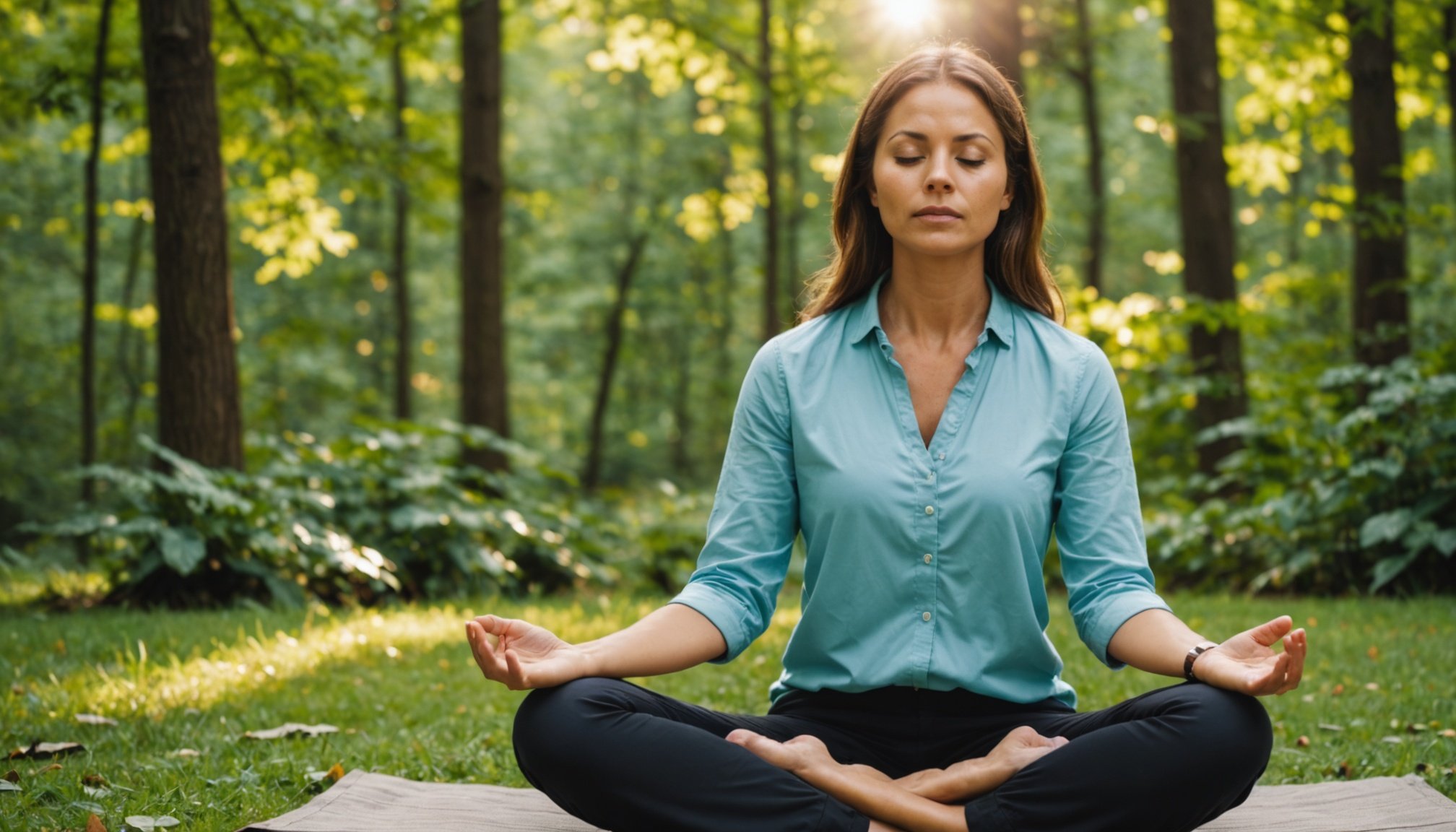The Ultimate Guide to the Best Meditation Techniques for Effective Chronic Anxiety Relief
In today’s fast-paced world, anxiety and stress have become ubiquitous companions for many of us. However, there are powerful tools that can help you manage and even overcome these challenges. One of the most effective and timeless methods is meditation. In this guide, we will delve into the best meditation techniques that can provide significant relief from chronic anxiety.
Understanding Meditation and Its Benefits
Before we dive into the various techniques, it’s essential to understand what meditation is and how it can benefit your mental and physical health. Meditation is a practice that involves focusing your attention on a particular object, thought, or activity to achieve a mentally clear and emotionally calm state. It has been practiced for thousands of years and is now backed by a wealth of scientific research.
Also read : Top Foods to Eliminate for Easing Irritable Bowel Syndrome Symptoms
“Meditation isn’t about sitting and being silent,” explains a guide from West End Wellness. “It’s about focusing your attention on something and allowing yourself to be aware of your thoughts and feelings without judgment”.
Meditation has numerous benefits, including reducing stress and anxiety, improving sleep quality, enhancing concentration, and boosting overall mental health. Here are some key benefits:
Topic to read : Unlocking Pure Water: The Ultimate Guide to the Best Contaminant Removal Filtration Systems
- Reduces Stress and Anxiety: Meditation helps in lowering cortisol levels, the hormone associated with stress, and can significantly reduce symptoms of anxiety and depression.
- Improves Sleep: Regular meditation practice can improve the quality of your sleep by relaxing the body and mind.
- Enhances Concentration: By training the mind to focus, meditation can improve attention and concentration.
- Boosts Mental Health: Meditation can help in managing chronic pain, heart disease, and other mental health conditions.
Mindfulness Meditation
Mindfulness meditation is one of the most common and effective techniques for managing anxiety. This practice involves being fully present and aware of your current surroundings and thoughts without judgment.
How to Practice Mindfulness Meditation
- Find a Comfortable Position: Sit in a quiet place, either on a chair or on a meditation cushion, with your feet on the ground.
- Focus on Your Breath: Close your eyes and focus on your breath. Feel the sensation of the air entering and leaving your nostrils.
- Be Aware of Your Thoughts: When your mind wanders, gently bring your attention back to your breath. Do not judge your thoughts; simply observe them.
- Body Scan: Occasionally, perform a body scan to notice any physical sensations or tension in your body.
Benefits of Mindfulness Meditation
Mindfulness meditation is particularly beneficial for reducing stress and anxiety. Here are some key benefits:
- Reduces Stress: Mindfulness meditation can lower cortisol levels and reduce overall stress.
- Improves Emotional Regulation: It helps in managing emotions and reducing the impact of anxiety on daily life.
- Enhances Self-Awareness: By being more aware of your thoughts and feelings, you can better understand and manage your anxiety.
Guided Meditation
Guided meditation, also known as guided imagery or visualization, is another powerful technique for anxiety relief. This method involves following the instructions of a guide to create a relaxing and calming mental environment.
How to Practice Guided Meditation
- Choose a Guide: Use a guided meditation app like Headspace, Calm, or find videos on YouTube.
- Follow the Instructions: The guide will lead you through a series of steps, often involving visualization of a peaceful place, body scan, or breathing exercises.
- Engage Your Senses: Use as many senses as possible to make the experience more vivid and relaxing. For example, imagine the sights, sounds, and feelings of a serene beach.
Benefits of Guided Meditation
Guided meditation is highly effective for several reasons:
- Easy to Follow: It is particularly helpful for beginners as it provides a clear and structured approach.
- Customizable: You can choose guides that focus on specific issues, such as anxiety, sleep, or stress relief.
- Immediate Relief: Guided meditation can provide immediate relaxation and stress reduction.
Progressive Muscle Relaxation (PMR)
Progressive Muscle Relaxation is a technique that combines physical relaxation with breathing exercises to manage stress and anxiety.
How to Practice PMR
- Preparation: Find a quiet and comfortable place, remove your shoes, and wear loose clothing. Consult your doctor if you have any underlying medical conditions.
- Tension and Relaxation: Tense a specific muscle group as you inhale, hold for 5-10 seconds, and then relax as you exhale. Focus on the changing sensations and the feeling of relaxation spreading through your body.
- Sequence of Muscle Groups: Follow a specific sequence, such as starting with your toes and moving up to your head, tensing and relaxing each group in turn.
Benefits of PMR
PMR is highly effective for several reasons:
- Directly Addresses Physical Tension: By tensing and relaxing muscles, PMR directly addresses the physical manifestations of anxiety.
- Reduces Anxiety Symptoms: It has been proven to relieve symptoms of anxiety, insomnia, stress, and even chronic pain.
- Improves Overall Relaxation: Regular practice can lead to a deeper sense of relaxation and reduced overall stress levels.
Breathing Techniques for Anxiety Relief
Breathing exercises are a fundamental part of many meditation practices and can be incredibly effective in reducing anxiety.
Types of Breathing Exercises
Here are some of the most beneficial breathing techniques:
- 4-7-8 Breathing: Inhale through your nose for four seconds, hold your breath for seven seconds, and exhale through your mouth for eight seconds. This technique can help slow down your heart rate and lower blood pressure.
- Belly Breathing: Inhale deeply through your nose, allowing your stomach to expand, and then exhale slowly through your mouth, constricting your lower belly. This helps in engaging the diaphragm and promoting deeper, calmer breathing.
- Lion’s Breath: Inhale, then exhale through your mouth with a “ha” sound, sticking out your tongue. This technique can help release tension and promote relaxation.
Benefits of Breathing Techniques
Breathing exercises offer several benefits:
- Immediate Relaxation: These techniques can provide immediate relief from stress and anxiety.
- Improves Sleep: Deep breathing can improve sleep quality by relaxing the body and mind.
- Reduces Cortisol Levels: Regular practice can lower cortisol levels, reducing overall stress and anxiety.
Table: Comparison of Meditation Techniques
| Technique | Description | Benefits | Best For |
|---|---|---|---|
| Mindfulness Meditation | Focus on breath and body sensations without judgment | Reduces stress, improves emotional regulation, enhances self-awareness | Beginners, general stress relief |
| Guided Meditation | Follow a guide to visualize a relaxing environment | Easy to follow, customizable, immediate relief | Beginners, specific issues |
| Progressive Muscle Relaxation | Tense and relax muscle groups to release physical tension | Directly addresses physical tension, reduces anxiety symptoms | Physical tension, chronic pain |
| Breathing Techniques | Various techniques to focus on breath and relax the body | Immediate relaxation, improves sleep, reduces cortisol levels | Quick stress relief, sleep improvement |
Practical Insights and Actionable Advice
Starting Your Meditation Practice
- Find a Quiet Space: Identify a quiet and comfortable place where you can meditate without distractions.
- Set a Schedule: Start with short sessions, such as 10 minutes a day, and gradually increase the time as you become more comfortable with the practice.
- Use Guided Resources: Utilize apps, videos, or audio recordings to guide you through your meditation sessions, especially if you are a beginner.
Making Meditation a Habit
- Consistency is Key: Aim to meditate at the same time every day to make it a habit.
- Be Patient: It may take some time to see the benefits, so be patient and persistent with your practice.
- Combine with Other Techniques: Incorporate other relaxation techniques, such as yoga or deep breathing exercises, to enhance your meditation practice.
Quotes and Expert Insights
- “The one thing you always have is your breath,” says psychologist and holistic health practitioner Niloo Dardashti. “Breathing exercises are easy to do, cost nothing, and are always available”.
- “Meditation isn’t about sitting and being silent. It’s about focusing your attention on something and allowing yourself to be aware of your thoughts and feelings without judgment,” explains a guide from West End Wellness.
- “Progressive Muscle Relaxation has endured as a relaxation technique due to its pragmatic, tangible approach to relieving tension, anxiety, and stress,” notes an article on Positive Psychology.
Meditation is a powerful tool that can significantly reduce chronic anxiety and improve overall mental and physical health. Whether you choose mindfulness meditation, guided meditation, progressive muscle relaxation, or breathing techniques, the key is to find what works best for you and make it a consistent part of your daily routine.
Remember, the benefits of meditation are not limited to immediate stress relief; regular practice can lead to long-term improvements in mental health, sleep quality, and overall well-being. So, take the first step today, and discover the transformative power of meditation for yourself.











